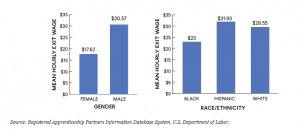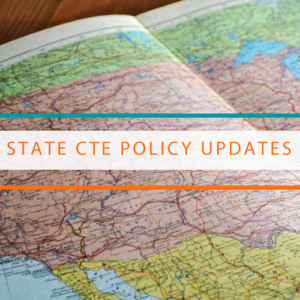Advance CTE serves as a steering member of the College in High School Alliance, a coalition of national, state, and local organizations collaborating to enable high school students to enroll in authentic, affordable college pathways toward postsecondary degrees and credentials offered with appropriate support. This blog series elevates resources and work states are doing to design and deliver high-quality college in the high school programs. For the first blog in this series, Advance CTE interviewed Coordinator of the College in High School Alliance (CHSA) Alex Perry, to learn how the organization supports state CTE leaders.
 When was College in High School Alliance (CHSA) established and who were its founders? Was there a catalyst for its inception?
When was College in High School Alliance (CHSA) established and who were its founders? Was there a catalyst for its inception?
The College in High School Alliance (CHSA) was founded in 2017. The original five founding members of our Steering Committee – Bard College, Jobs for the Future (JFF), KnowledgeWorks, the Middle College National Consortium, and the National Alliance of Concurrent Enrollment Partnerships – had been working together informally for a couple of years prior to the formal creation of CHSA, and were very successful in working together to create new policy and funding incentives for dual enrollment through the Every Student Succeeds Act reauthorization process in 2015.
Together, we saw the power of the collective and that collaboration on items of shared interest netted positive results for our work and the learners that we serve. CHSA was born from that promise – that we could collectively advance policy reforms to improve learner access and success to dual enrollment. Two years later, CHSA added Advance CTE and Achieving the Dream to its Steering Committee to expand the core collaboration.
What are college in high school programs, why are these programs important for a learner’s journey, and how do they intersect with Career Technical Education (CTE)?
College in high school programs are partnerships between high schools and institutions of higher education that allow high school learners to earn college credits. These programs go by many names across the country including dual enrollment, dual credit, concurrent enrollment, early college high school, Running Start, etc.
These programs have a strong intersection with Career Technical Education (CTE) as approximately one-third of dual enrollment programs have a CTE focus to them.1 Additionally, structured CTE programs like youth apprenticeship include learners taking college courses in high school as part of the apprenticeship structure. Dual enrollment in CTE is a key avenue for encouraging learners to complete postsecondary credentials and enter the workforce with appropriate skills and credentials for economic success.
College in high school programs are quite popular currently, but there is still unequal access for learners. How does CHSA center equity in college in the high school program conversations?
Equity is at the very core of our work with policymakers. We know college in high school programs like dual enrollment can be very successful in boosting postsecondary access and success for learners – but we also know that access is unequal. Populations experiencing equity gaps are the same populations of learners who are seeing the biggest declines in postsecondary access and success, for whom an intervention like dual enrollment might be life changing. Policy, and particularly federal and state funding, should be used to provide learners who need it the most with potentially life changing opportunities.
Based on CHSA’s work, what findings would you highlight for state CTE leaders in particular?
In March of 2022, CHSA and Advance CTE published The State of CTE: Early Postsecondary Opportunities resource, based on a nationwide survey of state CTE leaders about early postsecondary opportunities (EPSOs) like dual enrollment. The findings make clear the charge for the work ahead, which involves continuing to lean in heavily on the mission to increase equity for learners, thinking about systemwide supports for learners, better data collection and improving credit transfer.
What new questions has CHSA’s work raised that you would like to apply to future research?
With the influx of dual enrollment opportunities happening across the nation, it is really important that we continue to explore questions around outcomes for learners, assessing what the research can tell us about the number and kind of course experiences that are optimal for learners to promote their college and career success. Additionally, we must begin to look into the different designs of dual enrollment programs to better understand how program design influences learner outcomes from diverse learner populations.
CHSA has recently worked on a resource that highlights 150 research questions specific to the field, and a forthcoming publication will be feature questions with the highest priority.
To learn more about Early Postsecondary Opportunities please visit The State of CTE: Early Postsecondary Opportunities in the Advance CTE resource center.
Suela Cela, Senior Policy Associate


 Lawmakers Pass Debt Ceiling Deal
Lawmakers Pass Debt Ceiling Deal

 As part of ongoing blog topics aimed at supporting all learners in the realization of the national vision for the future of Career Technical Education (CTE),
As part of ongoing blog topics aimed at supporting all learners in the realization of the national vision for the future of Career Technical Education (CTE),  The 2022 school year heralded the start of another new initiative for the District of Columbia’s Office of the State Superintendent of Education (OSSE)- the
The 2022 school year heralded the start of another new initiative for the District of Columbia’s Office of the State Superintendent of Education (OSSE)- the  October 7 was National Manufacturing Day but, in Ohio, the celebration lasts the entire month. . Ohio uses this time to raise awareness of the various manufacturing pathways available to learners in the state and inspire those learners to join. Ohio already has significant investments in the manufacturing economy which generates more than $125 billion. However, knowledge of how many different skill sets and jobs are available in the industry is still not widespread. By taking advantage of Manufacturers Month, this post highlights the innovative ways Ohio is uplifting the manufacturing pathway as well as leveraging the support of The Ohio Manufacturers’ Association (OMA), which is bringing awareness to various grants and programs, some of which have been made recently available to Ohio residents.
October 7 was National Manufacturing Day but, in Ohio, the celebration lasts the entire month. . Ohio uses this time to raise awareness of the various manufacturing pathways available to learners in the state and inspire those learners to join. Ohio already has significant investments in the manufacturing economy which generates more than $125 billion. However, knowledge of how many different skill sets and jobs are available in the industry is still not widespread. By taking advantage of Manufacturers Month, this post highlights the innovative ways Ohio is uplifting the manufacturing pathway as well as leveraging the support of The Ohio Manufacturers’ Association (OMA), which is bringing awareness to various grants and programs, some of which have been made recently available to Ohio residents.  In August, the OMA was named one of the 32 finalists for the “
In August, the OMA was named one of the 32 finalists for the “